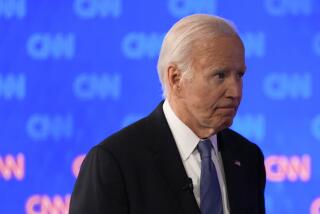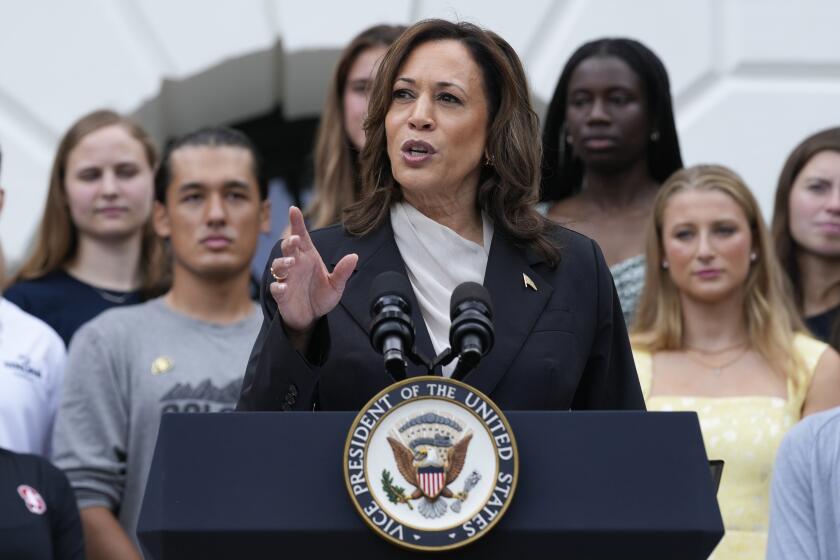Inflation Is Dying; Long Live the Promise of Low Interest Rates
Audiences always shed a tear at the best monster movies--when Godzilla crashed into the sea, for instance, or a sad-eyed King Kong finally slid off the Empire State Building.
So it is with the early announcements of the death of inflation, however premature they may be. Most economists, like Fay Wray’s boyfriend, are ruddily cheerful about the beast’s apparent demise, but much of the rest of the country will have decidedly mixed emotions.
Vice President George Bush led the mourners at inflation’s bier earlier this month when he deplored oil prices that were “free fall, like a parachutist without a parachute.” Besides the oil companies, misty-eyed casket watchers might have included a good number of the country’s real-estate investors, many of the larger banks, most farmers and, perhaps surprisingly, a substantial number of retirees.
The first question, of course, is whether obituaries for inflation are or are not premature. Economists have had a dismal forecasting record throughout the 1980s, so no great comfort can be derived from the current unanimity that inflation is a dead issue. But at the same time, the fundamentals, as they say, look good.
The recent free fall in oil prices comes on top of declining prices for most commodities, from food to metals. In recent months, we have actually been treated to a substantial bout of de flation. During the first quarter of 1986, the producer price index plummeted at an annual rate of 12.4%, and the fall in consumer prices in February and March was the sharpest in 36 years.
Falling prices mean that cost-of-living increases in union contracts and Social Security will not be triggered. Deregulation continues to drive down air fares, truck rates, even the costs of stock trading. Electronic technology is lowering the prices of everything from kitchen mixers to wrist watches, just as prices in the computer industry have fallen for years. There is still plenty of slack in industrial capacity, so there is little likelihood of near-term producer bottlenecks. And interest rates are finally starting to follow commodity prices down.
There are countervailing pressures, of course. Oil prices should begin to firm as big companies rebuild inventories after waiting to see how far prices could fall. The falling dollar will also inevitably push up the price of imports, although so far the big Japanese exporters have been able to absorb most of the dollar’s fall by trimming their huge profit margins.
There is no doubt that the world is better off with lower inflation. Each 10% drop in oil prices, economists figure, adds about a quarter-percent growth in output for the industrialized oil-importing nations. Businesses that were barely breaking even find that they can make a profit, as jobs and investment expand throughout the entire economy.
But glowing benefits in the aggregate can conceal some nasty specifics. After almost 20 years of rapid inflation, individuals and businesses began to assume that it would continue at high levels forever. Farmers are an obvious example. They borrowed heavily in the 1970s to speculate in land, betting that rising food prices and land values would bail out their loans and leave them hefty profits. They bet wrong. Farm Belt foreclosures are at Depression levels and the entire Farm Credit System teeters toward collapse.
According to conventional wisdom, bankers prefer low inflation because it ensures that their outstanding loans are not paid back with depreciated dollars. But better that loans be paid back with cheap money than not paid back at all. With their staff economists confidently predicting perpetual inflation, banks encouraged lending officers to take on assets driven by inflation--real-estate loans, oil-based loans to Texas wildcatters and Mexican bureaucrats, farm-belt loans. All of them are going under water.
Serious problems at the banks are being masked by the first stages of the disinflationary cycle. Bank profits are temporarily pumped up because bank borrowing costs are falling much faster than the interest rates they charge to customers. Witness the 18%-20% rates still charged on most bank credit cards. Sooner or later, however, as bank interest spreads narrow, the fragility of their balance sheets will become painfully evident.
Again, conventional wisdom insists that inflation exacts its cruelest toll from the elderly--the proverbial widow on a fixed income. But the long inflationary run of the past two decades has worked dramatic changes in that picture. For one thing, since 1972, Social Security rules have generally meant that benefit payments increased faster than inflation; continuing inflation, in other words, has resulted in a slowly growing share of national income directed toward the elderly.
More important, the elderly, by and large, have very healthy personal balance sheets, primarily because of the rise in the value of their houses over the years. And if they have cashed-in their houses, they have become accustomed to 10%-12% rates of return on their savings. A nationwide leveling-off in home prices and the steady decline in savings interest rates will have a sharply negative impact on the income and the expectations of a very large number of the old.
As might be expected, almost everyone who bet wrong on inflation is asking for government help to keep prices higher. Gov. Mark White of Texas, for example, has conveniently forgotten the “Turn Up the Heat, Freeze a Yankee” bumper stickers of a few years ago and wants federal action to prop up domestic oil prices--a special tariff on imported oil would do quite nicely, he thinks.
Similar requests come from farm banks and overmortgaged farmers. More price supports would keep farm prices high--and build more government cheese mountains--while the taxpayers bail out the farm banks. And the elderly will lobby for cost-of-living increases, whether the cost of living goes up or down.
Disinflation is painful. But the benefits will be enormous. Stable price expectations and low interest rates mean an opportunity for the kind of steady, non-inflationary national growth that characterized much of the 1950s and the early 1960s. That period now seems like a golden age, one that seemed gone forever. But the United States is entering a period of relative demographic stability. If protectionism does not snuff out a recovery in world trade, if special-interest legislation does not interfere with disinflation in America, if we act, in short, with courage and forbearance, we could enjoy another period of steadily growing productivity and living standards that few would have thought possible only a short time ago. Another golden age could be upon us.
More to Read
Get the L.A. Times Politics newsletter
Deeply reported insights into legislation, politics and policy from Sacramento, Washington and beyond. In your inbox three times per week.
You may occasionally receive promotional content from the Los Angeles Times.






